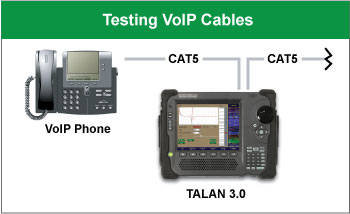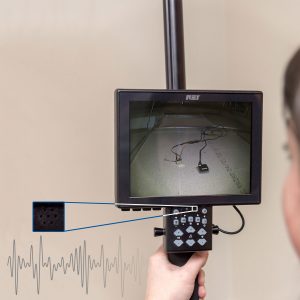Have you attended REI’s Training Center? If so, you can add those training courses to your LinkedIn profile under the Certifications section. This communicates to peers and potential employers that you’ve successfully completed technical security training at the world’s largest commercial center. Here’s how: Continue reading “Add REI Training To Your LinkedIn Profile”
Tag: How To

A. Physical Line Test
The LINE and PHONE ports on the TALAN input panel are used when testing conductivity of analog, digital and VoIP cable conductors. This is where DMM, NLJD, FDR and other line tests can check for conductive anomalies on VoIP cables.
 Not only can the VPC 2.0 capture video while in use, it also features a built-in microphone. This microphone adds the ability to provide voice descriptions of what the user is seeing. Pairing the audio along with the captured video provides essential context when reviewing the footage at a later time. Continue reading “Tech Note: Recording Audio with VPC 2.0”
Not only can the VPC 2.0 capture video while in use, it also features a built-in microphone. This microphone adds the ability to provide voice descriptions of what the user is seeing. Pairing the audio along with the captured video provides essential context when reviewing the footage at a later time. Continue reading “Tech Note: Recording Audio with VPC 2.0”
The TALAN is capable of detecting VoIP packets on VoIP phone systems using the 10/100 Mbps rate. The TALAN VoIP Test Adapter will force some Gigabit VoIP systems to auto-negotiate to the 10/100 Mbps rate. However, some VoIP network systems may not be fully compatible with the VoIP Test Adapter, or have been set up not to auto negotiate down. Below are compatibility issues that may be encountered and also solutions:
Continue reading “Testing Gigabit VoIP Systems with TALAN 3.0”
REI’s CPM-700 was the standard in RF broadband detection for over 20 years in the TSCM market. Now the ANDRE offers many more features to its users. The ANDRE includes robust tools to help identify what type of signals are being encountered and offers powerful post-sweep analysis functions not available in other broadband detectors.
HOW THE SIGNAL LIST WORKS
The ANDRE automatically generates a list of detected signals that exceed the designated trigger level and register on the frequency counter. These signals display from strongest initial RF level at the top to weakest at the bottom and can be customized to show 10, 25, 50, or 250 signals. Even when the signal list display is full, the ANDRE continues to capture weaker signal information. If a newly-detected signal is stronger than another in the list, the list automatically re-sorts and weaker signals roll off.
In the previous REI newsletter we discussed the importance of spectrum analyzer mobility in order to locate transmitters. Detecting and identifying types of signals is very important, but locating transmitters is equally, if not more important if you want to find malicious surveillance devices, and that requires a portable receiver. Moving the spectrum analyzer reveals changes in signal amplitude as it gets closer or further away from a signal’s source.
 To assist with report writing and analysis after a sweep is complete, the OSCOR provides the ability to capture various types of information from the display, demodulated video, and audio signals. All information captured is stored to either a compact flash card or a USB storage device, not the OSCOR itself. In order to recognize an external USB hard drive, the device must be formatted with a FAT file system such as FAT32. If needed, the OSCOR can format the hard drive using the Storage Manager feature (see page 22 of the OSCOR Green manual).
To assist with report writing and analysis after a sweep is complete, the OSCOR provides the ability to capture various types of information from the display, demodulated video, and audio signals. All information captured is stored to either a compact flash card or a USB storage device, not the OSCOR itself. In order to recognize an external USB hard drive, the device must be formatted with a FAT file system such as FAT32. If needed, the OSCOR can format the hard drive using the Storage Manager feature (see page 22 of the OSCOR Green manual).
